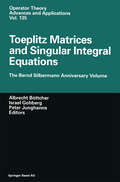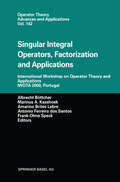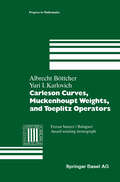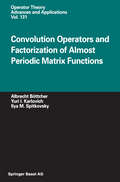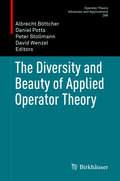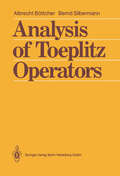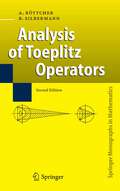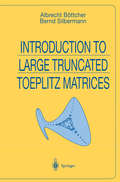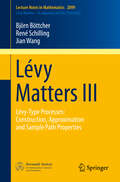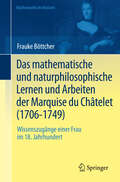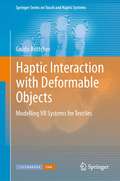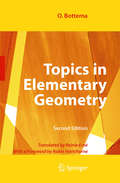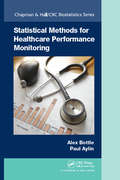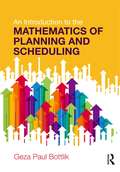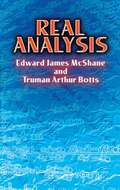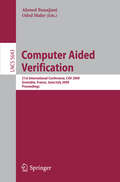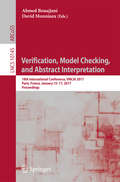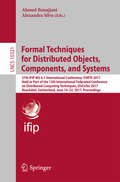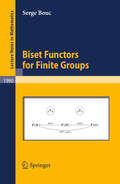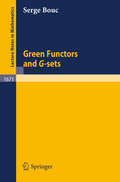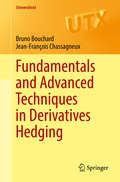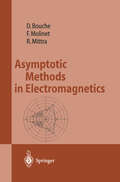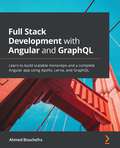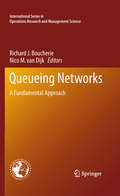- Table View
- List View
Toeplitz Matrices and Singular Integral Equations: The Bernd Silbermann Anniversary Volume (Operator Theory: Advances and Applications #135)
by Albrecht Böttcher Israel Gohberg P. JunghannsSingular Integral Operators, Factorization and Applications: International Workshop on Operator Theory and Applications IWOTA 2000, Portugal (Operator Theory: Advances and Applications #142)
by Albrecht Böttcher Marinus A. Kaashoek Amarino Brites Lebre António F. Dos Santos Frank-Olme SpeckThis volume contains the proceedings of the International Workshop on Operator Theory and Applications held at the University of Algarve in Faro, Portugal, September 12-15, in the year 2000. The main topics of the conference were !> Factorization Theory; !> Factorization and Integrable Systems; !> Operator Theoretical Methods in Diffraction Theory; !> Algebraic Techniques in Operator Theory; !> Applications to Mathematical Physics and Related Topics. A total of 94 colleagues from 21 countries participated in the conference. The major part of participants came from Portugal (32), Germany (17), Israel (6), Mexico (6), the Netherlands (5), USA (4) and Austria (4). The others were from Ukraine, Venezuela (3 each), Spain, Sweden (2 each), Algeria, Australia, Belorussia, France, Georgia, Italy, Japan, Kuwait, Russia and Turkey (one of each country). It was the 12th meeting in the framework of the IWOTA conferences which started in 1981 on an initiative of Professors 1. Gohberg (Tel Aviv) and J. W. Helton (San Diego). Up to now, it was the largest conference in the field of Operator Theory in Portugal.
Carleson Curves, Muckenhoupt Weights, and Toeplitz Operators (Progress in Mathematics #154)
by Albrecht Böttcher Yuri I. KarlovichAward-winning monograph of the Ferran Sunyer i Balaguer Prize 1997. This book is a self-contained exposition of the spectral theory of Toeplitz operators with piecewise continuous symbols and singular integral operators with piecewise continuous coefficients. It includes an introduction to Carleson curves, Muckenhoupt weights, weighted norm inequalities, local principles, Wiener-Hopf factorization, and Banach algebras generated by idempotents. Some basic phenomena in the field and the techniques for treating them came to be understood only in recent years and are comprehensively presented here for the first time.The material has been polished in an effort to make advanced topics accessible to a broad readership. The book is addressed to a wide audience of students and mathematicians interested in real and complex analysis, functional analysis and operator theory.
Convolution Operators and Factorization of Almost Periodic Matrix Functions (Operator Theory: Advances and Applications #131)
by Albrecht Böttcher Yuri I. Karlovich Ilya M. SpitkovskyMany problems of the engineering sciences, physics, and mathematics lead to con volution equations and their various modifications. Convolution equations on a half-line can be studied by having recourse to the methods and results of the theory of Toeplitz and Wiener-Hopf operators. Convolutions by integrable kernels have continuous symbols and the Cauchy singular integral operator is the most prominent example of a convolution operator with a piecewise continuous symbol. The Fredholm theory of Toeplitz and Wiener-Hopf operators with continuous and piecewise continuous (matrix) symbols is well presented in a series of classical and recent monographs. Symbols beyond piecewise continuous symbols have discontinuities of oscillating type. Such symbols emerge very naturally. For example, difference operators are nothing but convolution operators with almost periodic symbols: the operator defined by (A
The Diversity and Beauty of Applied Operator Theory (Operator Theory: Advances and Applications #268)
by Albrecht Böttcher Daniel Potts Peter Stollmann David WenzelThis book presents 29 invited articles written by participants of the International Workshop on Operator Theory and its Applications held in Chemnitz in 2017. The contributions include both expository essays and original research papers illustrating the diversity and beauty of insights gained by applying operator theory to concrete problems. The topics range from control theory, frame theory, Toeplitz and singular integral operators, Schrödinger, Dirac, and Kortweg-de Vries operators, Fourier integral operator zeta-functions, C*-algebras and Hilbert C*-modules to questions from harmonic analysis, Monte Carlo integration, Fibonacci Hamiltonians, and many more. The book offers researchers in operator theory open problems from applications that might stimulate their work and shows those from various applied fields, such as physics, engineering, or numerical mathematics how to use the potential of operator theory to tackle interesting practical problems.
Analysis of Toeplitz Operators (Springer Monographs in Mathematics)
by Albrecht Böttcher Bernd SilbermannA revised introduction to the advanced analysis of block Toeplitz operators including recent research. This book builds on the success of the first edition which has been used as a standard reference for fifteen years. Topics range from the analysis of locally sectorial matrix functions to Toeplitz and Wiener-Hopf determinants. This will appeal to both graduate students and specialists in the theory of Toeplitz operators.
Analysis of Toeplitz Operators (Springer Monographs in Mathematics)
by Albrecht Böttcher Bernd SilbermannA revised introduction to the advanced analysis of block Toeplitz operators including recent research. This book builds on the success of the first edition which has been used as a standard reference for fifteen years. Topics range from the analysis of locally sectorial matrix functions to Toeplitz and Wiener-Hopf determinants. This will appeal to both graduate students and specialists in the theory of Toeplitz operators.
Introduction to Large Truncated Toeplitz Matrices (Universitext)
by Albrecht Böttcher Bernd SilbermannApplying functional analysis and operator theory to some concrete asymptotic problems of linear algebra, this book contains results on the stability of projection methods, deals with asymptotic inverses and Moore-Penrose inversion of large Toeplitz matrices, and embarks on the asymptotic behaviour of the norms of inverses, the pseudospectra, the singular values, and the eigenvalues of large Toeplitz matrices. The approach is heavily based on Banach algebra techniques and nicely demonstrates the usefulness of C*-algebras and local principles in numerical analysis, including classical topics as well as results and methods from the last few years. Though employing modern tools, the exposition is elementary and points out the mathematical background behind some interesting phenomena encountered with large Toeplitz matrices. Accessible to readers with basic knowledge in functional analysis, the book addresses graduates, teachers, and researchers and should be of interest to everyone who has to deal with infinite matrices (Toeplitz or not) and their large truncations.
Lévy Matters III: Lévy-Type Processes: Construction, Approximation and Sample Path Properties (Lecture Notes in Mathematics #2099)
by Björn Böttcher René Schilling Jian WangThis volume presents recent developments in the area of Lévy-type processes and more general stochastic processes that behave locally like a Lévy process. Although written in a survey style, quite a few results are extensions of known theorems, and others are completely new. The focus is on the symbol of a Lévy-type process: a non-random function which is a counterpart of the characteristic exponent of a Lévy process. The class of stochastic processes which can be associated with a symbol is characterized, various schemes constructing a stochastic process from a given symbol are discussed, and it is shown how one can use the symbol in order to describe the sample path properties of the underlying process. Lastly, the symbol is used to approximate and simulate Levy-type processes.This is the third volume in a subseries of the Lecture Notes in Mathematics called Lévy Matters. Each volume describes a number of important topics in the theory or applications of Lévy processes and pays tribute to the state of the art of this rapidly evolving subject with special emphasis on the non-Brownian world.
Das mathematische und naturphilosophische Lernen und Arbeiten der Marquise du Châtelet: Wissenszugänge einer Frau im 18. Jahrhundert (Mathematik im Kontext)
by Frauke BöttcherDie französische Marquise Émilie du Châtelet war zu ihren Lebzeiten eine weit über die Grenzen Frankreichs bekannte Mathematikerin und Naturphilosophin. Dies ist erstaunlich, da ihr und ihren Geschlechtsgenossinnen in der Epoche der Aufklärung der Zugang zu den höheren Bildungsinstitutionen verwehrt war. Das vorliegende Werk beschäftigt sich mit der Frage, welche Bildungszugänge zum mathematischen und naturwissenschaftlichen Wissen für du Châtelet bedeutsam waren. Im Kontext der Bildungs- und Wissenschaftsgeschichte zeigt die Analyse ihrer Biographie eine bemerkenswerte Frau, die schon im elterlichen Haus Zugang zu den akademischen Elementen des Wissens und den höfischen Wissenschaften Fontenellscher Prägung bekam. Dank ihres unbedingten 'Willens zu Wissen' erschloss sie sich Mathematik, Physik und Naturphilosophie durch Anleitung, Lehrbücher, Lektüren und Korrespondenzen. Als Lehrbuchautorin öffnete sie zudem anderen einen Zugang zur damals modernen Physik.
Haptic Interaction with Deformable Objects: Modelling VR Systems for Textiles (Springer Series on Touch and Haptic Systems)
by Guido BöttcherThe focus from most Virtual Reality (VR) systems lies mainly on the visual immersion of the user. But the emphasis only on the visual perception is insufficient for some applications as the user is limited in his interactions within the VR. Therefore the textbook presents the principles and theoretical background to develop a VR system that is able to create a link between physical simulations and haptic rendering which requires update rates of 1\,kHz for the force feedback. Special attention is given to the modeling and computation of contact forces in a two-finger grasp of textiles. Addressing further the perception of small scale surface properties like roughness, novel algorithms are presented that are not only able to consider the highly dynamic behaviour of textiles but also capable of computing the small forces needed for the tactile rendering at the contact point. Final analysis of the entire VR system is being made showing the problems and the solutions found in the work
Topics in Elementary Geometry
by O. BottemaThis small book, translated into English for the first time, has long been a unique place to find classical results from geometry, such as Pythagoras' theorem, the nine-point circle, Morley's triangle, and many other subjects. In addition, this book contains recent, geometric theorems which have been obtained over the past years. There are 27 independent chapters on a wide range of topics in elementary plane Euclidean geometry, at a level just beyond what is usually taught in a good high school or college geometry course. The selection of topics is intelligent, varied, and stimulating, and the author provides many thought-provoking ideas.
Statistical Methods for Healthcare Performance Monitoring (Chapman & Hall/CRC Biostatistics Series)
by Alex Bottle Paul AylinHealthcare is important to everyone, yet large variations in its quality have been well documented both between and within many countries. With demand and expenditure rising, it’s more crucial than ever to know how well the healthcare system and all its components – from staff member to regional network – are performing. This requires data, which inevitably differ in form and quality. It also requires statistical methods, the output of which needs to be presented so that it can be understood by whoever needs it to make decisions. Statistical Methods for Healthcare Performance Monitoring covers measuring quality, types of data, risk adjustment, defining good and bad performance, statistical monitoring, presenting the results to different audiences and evaluating the monitoring system itself. Using examples from around the world, it brings all the issues and perspectives together in a largely non-technical way for clinicians, managers and methodologists. Statistical Methods for Healthcare Performance Monitoring is aimed at statisticians and researchers who need to know how to measure and compare performance, health service regulators, health service managers with responsibilities for monitoring performance, and quality improvement scientists, including those involved in clinical audits.
Statistical Methods for Healthcare Performance Monitoring (Chapman & Hall/CRC Biostatistics Series)
by Alex Bottle Paul AylinHealthcare is important to everyone, yet large variations in its quality have been well documented both between and within many countries. With demand and expenditure rising, it’s more crucial than ever to know how well the healthcare system and all its components – from staff member to regional network – are performing. This requires data, which inevitably differ in form and quality. It also requires statistical methods, the output of which needs to be presented so that it can be understood by whoever needs it to make decisions. Statistical Methods for Healthcare Performance Monitoring covers measuring quality, types of data, risk adjustment, defining good and bad performance, statistical monitoring, presenting the results to different audiences and evaluating the monitoring system itself. Using examples from around the world, it brings all the issues and perspectives together in a largely non-technical way for clinicians, managers and methodologists. Statistical Methods for Healthcare Performance Monitoring is aimed at statisticians and researchers who need to know how to measure and compare performance, health service regulators, health service managers with responsibilities for monitoring performance, and quality improvement scientists, including those involved in clinical audits.
An Introduction to the Mathematics of Planning and Scheduling
by Geza Paul BottlikThis book introduces readers to the many variables and constraints involved in planning and scheduling complex systems, such as airline flights and university courses. Students will become acquainted with the necessity for scheduling activities under conditions of limited resources in industrial and service environments, and become familiar with methods of problem solving. Written by an expert author with decades of teaching and industry experience, the book provides a comprehensive explanation of the mathematical foundations to solving complex requirements, helping students to understand underlying models, to navigate software applications more easily, and to apply sophisticated solutions to project management. This is emphasized by real-world examples, which follow the components of the manufacturing process from inventory to production to delivery. Undergraduate and graduate students of industrial engineering, systems engineering, and operations management will find this book useful in understanding optimization with respect to planning and scheduling.
Real Analysis
by Truman Arthur Botts Edward James McShaneThis text offers upper-level undergraduates and graduate students a survey of practical elements of real function theory, general topology, and functional analysis. Beginning with a brief discussion of proof and definition by mathematical induction, it freely uses these notions and techniques. The maximality principle is introduced early but used sparingly; an appendix provides a more thorough treatment. The notion of convergence is stated in basic form and presented initially in a general setting. The Lebesgue-Stieltjes integral is introduced in terms of the ideas of Daniell, measure-theoretic considerations playing only a secondary part. The final chapter, on function spaces and harmonic analysis, is deliberately accelerated. Helpful exercises appear throughout the text. 1959 edition.
Computer Aided Verification: 21st International Conference, CAV 2009, Grenoble, France, June 26 - July 2, 2009, Proceedings (Lecture Notes in Computer Science #5643)
by Ahmed Bouajjani Oded MalerThis book constitutes the refereed proceedings of the 21st International Conference on Computer Aided Verification, CAV 2009, held in Grenoble, France, in June/July 2009. The 36 revised full papers presented together with 16 tool papers and 4 invited talks and 4 invited tutorials were carefully reviewed and selected from 135 regular paper and 34 tool paper submissions. The papers are dedicated to the advancement of the theory and practice of computer-aided formal analysis methods for hardware and software systems; their scope ranges from theoretical results to concrete applications, with an emphasis on practical verification tools and the underlying algorithms and techniques.
Verification, Model Checking, and Abstract Interpretation: 18th International Conference, VMCAI 2017, Paris, France, January 15–17, 2017, Proceedings (Lecture Notes in Computer Science #10145)
by Ahmed Bouajjani David MonniauxThis book constitutes the refereed proceedings of the 18th International Conference on Verification, Model Checking, and Abstract Interpretation, VMCAI 2017, held in Paris, France, in January 2017. The 27 full papers together with 3 invited keynotes presented were carefully reviewed and selected from 60 submissions. VMCAI provides topics including: program verification, model checking, abstract interpretation and abstract domains, program synthesis, static analysis, type systems, deductive methods, program certification, debugging techniques, program transformation, optimization, hybrid and cyber-physical systems.
Formal Techniques for Distributed Objects, Components, and Systems: 37th IFIP WG 6.1 International Conference, FORTE 2017, Held as Part of the 12th International Federated Conference on Distributed Computing Techniques, DisCoTec 2017, Neuchâtel, Switzerland, June 19-22, 2017, Proceedings (Lecture Notes in Computer Science #10321)
by Ahmed Bouajjani Alexandra SilvaThis book constitutes the proceedings of the 37th IFIP WG 6.1 International Conference on Formal Techniques for Distributed Objects, Components, and Systems, FORTE 2017, held in Neuchâtel, Switzerland, in June 2017, as part of the 12th International Federated Conference on Distributed Computing Techniques, DisCoTec 2017. The 13 revised full papers presented together with 3 short and 1 tool papers were carefully reviewed and selected from 30 submissions. The papers present a wide range of topics on distributed computing models and formal specification, testing, and verification methods.
Biset Functors for Finite Groups (Lecture Notes in Mathematics #1990)
by serge BoucThis volume exposes the theory of biset functors for finite groups, which yields a unified framework for operations of induction, restriction, inflation, deflation and transport by isomorphism. The first part recalls the basics on biset categories and biset functors. The second part is concerned with the Burnside functor and the functor of complex characters, together with semisimplicity issues and an overview of Green biset functors. The last part is devoted to biset functors defined over p-groups for a fixed prime number p. This includes the structure of the functor of rational representations and rational p-biset functors. The last two chapters expose three applications of biset functors to long-standing open problems, in particular the structure of the Dade group of an arbitrary finite p-group.This book is intended both to students and researchers, as it gives a didactic exposition of the basics and a rewriting of advanced results in the area, with some new ideas and proofs.
Green Functors and G-sets (Lecture Notes in Mathematics #1671)
by serge BoucThis book provides a definition of Green functors for a finite group G, and of modules over it, in terms of the category of finite G-sets. Some classical constructions, such as the associated categroy or algebra, have a natural interpretation in that framework. Many notions of ring theory can be extended to Green functors (opposite Green functor, bimodules, Morita theory, simple modules, centres,...). There are moreover connections between Green functors for different groups, given by functors associated to bisets. Intended for researchers and students in representation theory of finite groups it requires only basic algebra and category theory, though knowledge of the classical examples of Mackey functors is probably preferable.
Fundamentals and Advanced Techniques in Derivatives Hedging (Universitext)
by Bruno Bouchard Jean-François ChassagneuxThis book covers the theory of derivatives pricing and hedging as well as techniques used in mathematical finance. The authors use a top-down approach, starting with fundamentals before moving to applications, and present theoretical developments alongside various exercises, providing many examples of practical interest.A large spectrum of concepts and mathematical tools that are usually found in separate monographs are presented here. In addition to the no-arbitrage theory in full generality, this book also explores models and practical hedging and pricing issues. Fundamentals and Advanced Techniques in Derivatives Hedging further introduces advanced methods in probability and analysis, including Malliavin calculus and the theory of viscosity solutions, as well as the recent theory of stochastic targets and its use in risk management, making it the first textbook covering this topic.Graduate students in applied mathematics with an understanding of probability theory and stochastic calculus will find this book useful to gain a deeper understanding of fundamental concepts and methods in mathematical finance.
Asymptotic Methods in Electromagnetics
by Daniel Bouche Frederic Molinet Raj MittraNumerically rigorous techniques for the computation of electromagnetic fields diffracted by an object become computationally intensive, if not impractical to handle, at high frequencies and one must resort to asymptotic methods to solve the scattering problem at short wavelengths. The asymptotic methods provide closed form expansions for the diffracted fields and are also useful for eliciting physical interpretations of the various diffraction phenomena. One of the principal objectives of this book is to discuss the different asymptotic methods in a unified manner. Although the book contains explicit formulas for computing the field diffracted by conducting or dielectric-coated objects, it also provides the mathematical foundations of the different methods and explains how they are interrelated.
Full-stack Development with Angular and Graphql: Build Scalable Modern Web Applications with Cutting-edge Technologies Including Graphql and Angular 12 (PDF)
by Ahmed BouchefraAngular is one of the most popular JavaScript frameworks in modern web app development allowing developers to not only build apps and reuse the code but also develop apps for any deployment target. For web, mobile web, native mobile, and native desktop, GraphQL is the modern and REST alternative for querying web APIs. Using Angular, TypeScript and GraphQL will give you a future-proof and scalable stack you can start building apps around. This book shows you how to build apps using cutting-edge technologies. You'll learn how to solve common web development problems with GraphQL and Apollo, such as database access, authentication, and image uploads. The book starts by introducing you to building full stack apps with Angular and GraphQL. Next, you'll learn how to create a monorepo project with Lerna and NPM Workspaces and configure a Node.js app to use GraphQL with Express and Apollo Server. You'll also understand the basics of Angular architecture and routing. Later, the book demonstrates how to build a professionally-looking UI with Angular Material, use Apollo Client to interface with the server to get data from the built GraphQL API. You'll learn about Apollo Client's type and field policies, and various fetching policies. In addition to this, you'll learn about local state management and reactive variables with Apollo Client and how to generate TypeScript types and even Angular Apollo services for your GraphQL schema and queries using GraphQL Code Generator to implement a scalable codebase. By the end of this book, you'll have the skills you need to be able to build your own full stack application.
Queueing Networks: A Fundamental Approach (International Series in Operations Research & Management Science #154)
by Richard J. Boucherie Nico M. Van DijkThis handbook aims to highlight fundamental, methodological and computational aspects of networks of queues to provide insights and to unify results that can be applied in a more general manner. The handbook is organized into five parts:Part 1 considers exact analytical results such as of product form type. Topics include characterization of product forms by physical balance concepts and simple traffic flow equations, classes of service and queue disciplines that allow a product form, a unified description of product forms for discrete time queueing networks, insights for insensitivity, and aggregation and decomposition results that allow sub networks to be aggregated into single nodes to reduce computational burden.Part 2 looks at monotonicity and comparison results such as for computational simplification by either of two approaches: stochastic monotonicity and ordering results based on the ordering of the process generators, and comparison results and explicit error bounds based on an underlying Markov reward structure leading to ordering of expectations of performance measures.Part 3 presents diffusion and fluid results. It specifically looks at the fluid regime and the diffusion regime. Both of these are illustrated through fluid limits for the analysis of system stability, diffusion approximations for multi-server systems, and a system fed by Gaussian traffic.Part 4 illustrates computational and approximate results through the classical MVA (mean value analysis) and QNA (queueing network analyzer) for computing mean and variance of performance measures such as queue lengths and sojourn times; numerical approximation of response time distributions; and approximate decomposition results for large open queueing networks.Part 5 enlightens selected applications as loss networks originating from circuit switched telecommunications applications, capacity sharing originating from packet switching in data networks, and a hospital application that is of growing present day interest.The book shows that the intertwined progress of theory and practice will remain to be most intriguing and will continue to be the basis of further developments in queueing networks.
